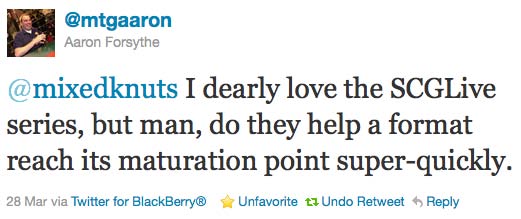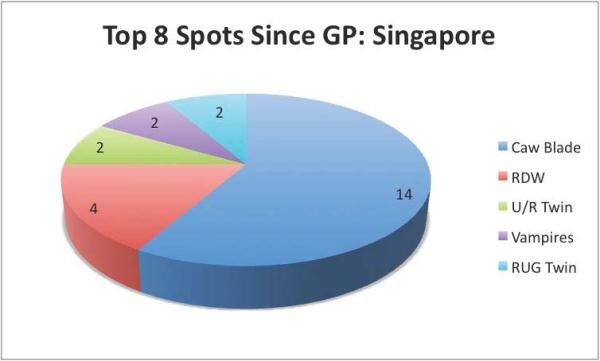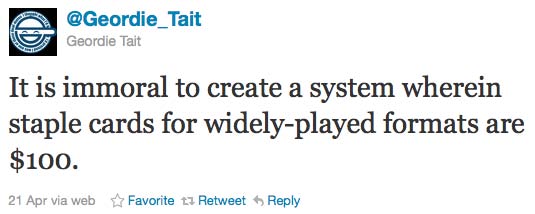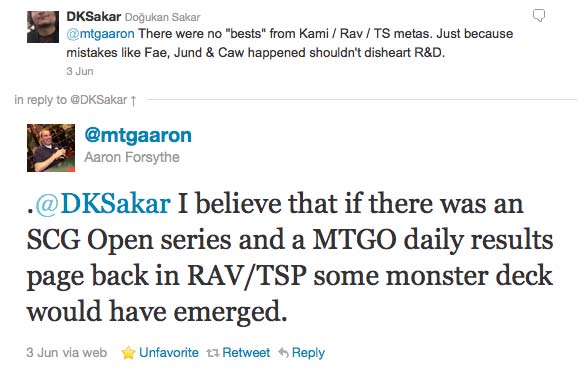One could argue that this is the best Standard format ever.

If we’re to believe the results from GP: Singapore and last weekend’s SCG Open in Denver, Standard is looking fairly healthy. Sure, in Singapore, the Top 8 was definitely skewed a bit (okay, more than a bit) toward Caw-Blade, but Boros made Top 8, as did U/B control, and a Caw-less Caw-Blade brew. Even more interesting are the results from the last two SCG Standard Opens, as well as the Standard decks that put people in the Top 8 at the SCG Invitational at Indianapolis.

Okay, so Caw-Blade is still the best deck—as if there were any question—and the one sending the most people to Top 8s. The chart compiles the paper Standard premier events since GP: Singapore, including SCG’s Standard Open in Indianapolis, the Standard decks of the Top 8 players of the SCG Invitational, and last weekend’s Open in Denver. I omitted the decks that were only represented once over the course of the two weekends, and there were a lot of them: Boros, U/B control, Caw-less Caw-Blade, R/U/G, Goblins, R/U/G Vengevine, Bant Vengevine, and Hawkward.
Even if we take GP: Singapore out of the equation, Caw-Blade’s numbers only go down by 5, making it a 9 on the chart instead of a 14. That’s still more than double the presence of the next closest deck, and more than four times the rest.
In spite of all that, it can still be argued that Standard is the best it’s ever been. Over the past year or so, the amount of technology made available to amateurs has grown by massive leaps and bounds. By creating an environment where excellent players can eke out a living just by following the series around the country,* Star City Games has given the amateur player a way to track changes that the top players are making to their decks week in and week out by making their deck lists public. Most PTQ hopefuls are used to looking at just articles and lists from MTGO Dailies for their tech. That seems like a lot of things to draw data from, but it’s important to remember that this data can be pretty flimsy; as a general rule, you usually want to be getting your data from someone much better than yourself, not a fellow PTQ grinder.
*Maybe now that SCG snap-nixed their byes, their top players will be less inclined to grind out the series as they’ve done in the past. We’ll have to see, I guess.
Now, with the SCG series, we not only get lists from pros every week, but we can watch their plays live, chart their changes from week to week, and adapt to every changing nuance of the meta with every Top 8. It seems like a small thing, but it’s huge. I promise.

One could argue the point that this is the worst Standard format ever.
There is a kind of hopelessness you feel when there’s a singular deck in Standard that is the best, that’s so good that there’s not even a number-two deck—the best deck is the only deck you should play, the only matchup you have to worry about is the mirror, and you go into every tournament with that mindset. And, heartbreakingly, you find that your wild, narrow assumptions are ultimately correct.
The only thing I can liken Caw-Blade to in terms of dominance is Affinity, back in 2004, the halcyon days of being a freshman in high school, Bush’s reelection, and the goddamn Patriots winning another Super Bowl.* I’m not counting the Skullclamp-driven decks of the era, just because they were too short-lived. Affinity and Caw-Blade run pretty parallel in terms of their dominance—the best players played both, the other strategies prepared for both and lost anyway, and both drove players out of the game in droves.
*As a Bills fan, and a red-blooded American who loves America and American things, I do not care for the Patriots.
The similarities end there. After a long time of people complaining and cashing out, as it were, of Magic altogether, the DCI stepped in and not only banned Arcbound Ravager, but Disciple of the Vault and all the artifact lands featured in Mirrodin, unfortunately killing a whole other deck, a very (comparatively) fair combo deck based on Krark-Clan Ironworks and Myr Incubator. All this banning, coupled with Kamigawa block, that effectively played Mercadian Masques to Mirrodin’s Urza’s Saga, caused Magic tournament attendance to fall off a cliff, finally landing with a poof (think Wile E. Coyote) during Saviors of Kamigawa.
It’s been a long road to recovery.
There are many more differences between Affinity and Caw-Blade than just lack of bannings. Affinity, a deck essentially wrought from two extremely linear mechanics, Affinity and Modular, was an uncommonly forgiving deck. Bad players can, and did, win with it. Caw-Blade is a deck whose core cards spans two blocks, four sets (Zendikar, Worldwake, Mirrodin Besieged, New Phyrexia), with some core set cards thrown in for good measure. While Affinity as a deck was linear to a fault and came pretty much tailor-made by R&D (although I’m certainly not saying I figured it out; these things are just easy to say in hindsight, I guess), Caw-Blade attacks on multiple levels, using the best cards. As a deck, Caw-Blade is inversely as forgiving as your opponent is good. As long as you’re playing someone a little worse than you, you can still make a few mistakes and get bailed out just on the power of better cards. If your opponent is better than you, no matter how big or small the margin, you’d better play tight, or your deck just won’t cough up the goods.
And then there’s the price of the deck. I think someone at WotC maybe tried to gouge the price of the deck by slipping Stoneforge Mystic into the deck, but that still doesn’t count Sword of Feast and Famine and Batterskull, the latter of which is gaining steady popularity in Legacy, and looking more and more likely every day to maintain its hefty price tag.
In short, Caw-Blade is the grinder’s wet dream. The best player wins every time. Less serious players are simply priced out of it completely. And you have nothing to blame your losses on but yourself.
I’ve lost lots of important matches. None of them have ever taken place on the Pro Tour, or even Day 2 of a Grand Prix (Jesus Christ, that’s embarrassing), but the feeling of losing when your back’s against the wall, and has been for a large chunk of the tournament, is common. Starting off a PTQ 1–1 and then going on a tear, only to lose the last round, thus sealing your Top-8-pin-less fate, feels as important and heartbreaking as anything. Losing to a player of comparable skill to you because of a little luck stings, sure, but you can go home with the solace of maybe, just maybe, those cards will fall your way some day, and maybe the kid’s mom won’t sit down next to you and start humming a song she just made up in the win-and-in round, and then maybe you won’t have to mainline Drano after going an entire match against a Doran deck without drawing a single Path to Exile. Maybe you’ll be the lucky one someday.
But when you’ve just been outplayed top to bottom, you were drawing dead from the minute you sat down, well, that inspires a different kind of hopelessness altogether.

Since the advent of the Pro Tour, back when I started kindergarten (Hi, Mrs. Contento!), Magic has been a game decided mostly by the players who can overcome the variance aspect of the game enough to do well consistently. The best players are the ones who are always drawing live. Sure, sometimes a random wins a Pro Tour. This is, to someone trying to make a living playing the game, acceptable. For them to be able to do their jobs, there has to be some semblance of hope for the bads that they, too, can succeed on the highest level.
Standard, in particular, is in a spot that it’s never been in before. There’s a deck that’s the clear best, no question about it, and takes away an unprecedented amount of variance from a match of Magic, takes an amount of variance away that’s never been seen before and will likely never be seen again. All the players who are doing the best seem to be grinding SCG’s Open series with this particular deck.
It’s almost impossible to be able to say, with a comfortable degree of certainty, what’s caused a deck like Caw-Blade to happen. Is it the advent of weekly premier events, and the tech they spurn? Mr. Forsythe clearly seems to think so. I’ve had the same sneaking suspicion myself, but it seems so crazy to think that every format, even an innocuous one, like, say, Kamigawa-Ravnica Constructed, a format with some very weak cards at the $20 mark (Hi, Cranial Extraction!), had some crazy control deck that was just the best, eliminated all concerns about variance, and whose mirror match was the ultimate test of skill between two magicians.
So does the blame for the dominance of Caw-Blade lie at the feet of the designers of the cards? Are Jace, the Mind Sculptor, Batterskull, and friends just too intrinsically powerful? Or is this group of cards just the first of many victims of fine-tuning and rapid metagame maturation at the hands of weekly premier events, and those who grind them? Are the SCG Opens actually hurting the game?
As much as I respect R&D, and WotC, and as much as I can definitely concede that they have an insanely tough job, and that I, as well as many other Magic players, don’t necessarily always know what it is that I want
Jon Corpora
pronounced ca-pora
























